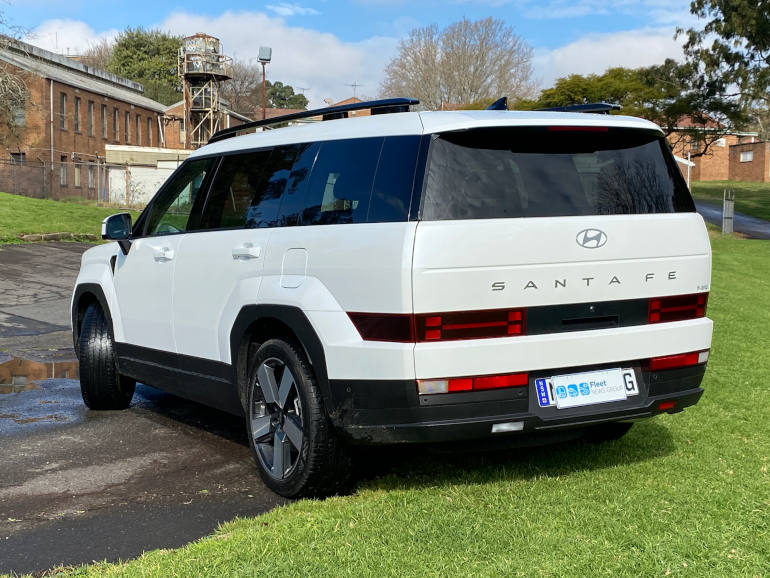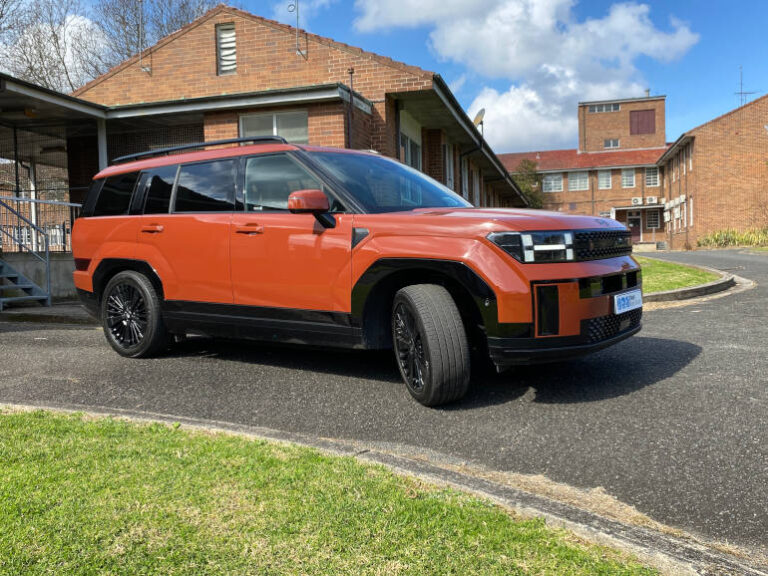When Hyundai first launched the Santa Fe in the late 1990s, it was their first foray into the SUV market. Over the years, this model has evolved dramatically, and with the release of the all-new 5th generation Santa Fe, Hyundai has truly redefined what it means to drive a family SUV. This latest iteration, featuring a hybrid powertrain, stands out not only in terms of design but also in performance and functionality.
I drove the base model and the top-tier Calligraphy. I’ll take you through the design, specifications, and the key differences so you can decide how much money to spend.
Design: Bold and boxy, with a purpose
The first thing you notice about the 5th generation Hyundai Santa Fe is its bold, boxy design. It’s a significant departure from the curvier and more subdued styling of its predecessor. In fact, this new design has been compared to that of a Range Rover, earning it the nickname “Korean Range Rover.” Hyundai seems to have designed this model with the American market in mind, where bigger and bolder are often better.
The Santa Fe’s new look is unmistakable on the road. Its large, rectangular grille, flanked by H-shaped LED headlights, gives it a commanding presence. The car’s profile is defined by sharp lines and a long wheelbase, which not only enhances its aesthetic appeal but also increases interior space. The rear is equally striking, with a wide tailgate that features vertically stacked taillights and a large Hyundai emblem.
Hyundai has also paid attention to the small details. The door handles, for instance, are finished in a sleek metallic silver, which contrasts nicely with the body color. Inside, the Santa Fe continues the theme of rugged sophistication. The dashboard is dominated by large digital displays, and the materials used throughout the cabin, including the soft-touch plastics and optional leather upholstery, are of high quality.

Specifications: What’s under the hood?
Under the bonnet, the 5th generation Santa Fe offers a 1.6-litre turbocharged hybrid powertrain. This system produces 172 kW of power and 360 Nm of torque, which is more than adequate for a vehicle of this size. The hybrid system also features smart regenerative braking, which adjusts the level of braking based on traffic conditions to maximise efficiency. The published fuel consumption is an impressive 5.6 litres per 100 kilometres, making it one of the most fuel-efficient SUVs in its class.
The Santa Fe is available in both front-wheel drive (FWD) and all-wheel drive (AWD) configurations. The base model comes with FWD as standard, while the higher trims offer AWD. Regardless of the drivetrain, the Santa Fe handles well for a vehicle of its size, though it does feel a bit disconnected from the road at times, particularly in terms of steering feedback.
Interior: Spacious and packed with technology
One of the standout features of the new Santa Fe is its interior space. This is a true seven-seater SUV, with plenty of room for passengers in all three rows. The seats are comfortable, and there’s ample legroom and headroom even in the third row, which is often a tight squeeze in many other SUVs.
The Santa Fe also offers plenty of storage space. The center console, for example, is massive, with enough room to store just about anything you might need on a long road trip. There are also additional storage compartments under the floating console, in the door pockets, and in the rear cargo area.
Technology is another strong point for the Santa Fe. The base model comes equipped with a large digital instrument cluster, a similarly large infotainment screen, wireless charging, and a host of advanced safety features. Hyundai’s SmartSense suite is standard across all trims and includes forward collision warning, lane-keeping assist, and adaptive cruise control, among others.
One feature that we particularly liked is the ability to open the centre console lid from both the front and the rear seats. This makes it easier for rear-seat passengers to access items stored in the console, which is a thoughtful touch, especially for families with children.
Base model vs. Calligraphy: What’s the difference?
The base model of the Santa Fe starts at around $55,000 (plus on-roads), and it comes well-equipped with all the essentials you would expect from a modern SUV. The interior features cloth seats with a tartan pattern, which we found to be both comfortable and stylish. While some might prefer leather, we appreciated the practicality of cloth, especially for families with older kids who might not be as prone to spills.
However, one area where the base model falls short is in the driver’s seat. While it is electrically adjustable, it lacks memory settings, which can be a minor annoyance if multiple drivers are using the vehicle. We would have preferred a manual seat that can be adjusted more quickly and easily.
On the other hand, the top-of-the-line Calligraphy trim, which comes in at around $85,000 drive away, is a whole different experience. The Calligraphy model we tested came in a stunning Terracotta Orange colour with black trim and 20-inch alloy wheels. The interior was just as impressive, with Pecan Brown Nappa leather-appointed seats that added a touch of luxury.
The Calligraphy trim also includes a number of features not available on the base model, such as heated and cooled seats, a heated steering wheel, and a panoramic sunroof. The driver’s seat not only has memory settings but also features additional adjustments for a more customised fit. Overall, the Calligraphy trim elevates the Santa Fe from a practical family SUV to a more luxurious and refined vehicle.
Driving experience: Smooth but disconnected
Driving the new Santa Fe is a mixed bag. On the one hand, the hybrid powertrain is smooth and responsive, offering plenty of power for both city driving and highway cruising. The transition between electric and petrol power is seamless, and it accelerates briskly when needed.
However, the driving experience does feel somewhat disconnected. The steering, in particular, lacks the feedback that driving enthusiasts might prefer. While this isn’t a major issue for a family SUV, it’s worth noting for those who enjoy a more engaging driving experience.
One feature that we found particularly annoying was the driver distraction technology. While we understand the need for safety systems, the alerts were often too loud and intrusive. We know that Hyundai has addressed this issue with some updates, an approach that considers the user experience as well as the safety standards would improve the ownership experience.
Final verdict
The 5th generation Hyundai Santa Fe is a significant improvement over its predecessor. It offers a spacious interior, advanced technology, and a fuel-efficient hybrid powertrain, all wrapped up in a bold new design. Whether you choose the base model or the fully-loaded Calligraphy trim, you’re getting a vehicle that is well-suited for family life.
However, it’s not without its quirks. The driving experience, while smooth, can feel a bit disconnected, and the driver distraction technology could be less intrusive. Additionally, while the Calligraphy trim offers a more luxurious experience, it comes at a steep price, which might make it less appealing for budget-conscious buyers.
That said, if you’re in the market for a large, comfortable, and practical SUV with the latest technology, the new Santa Fe is definitely worth considering. It’s a vehicle that not only meets the needs of a modern family but does so with style and sophistication.








